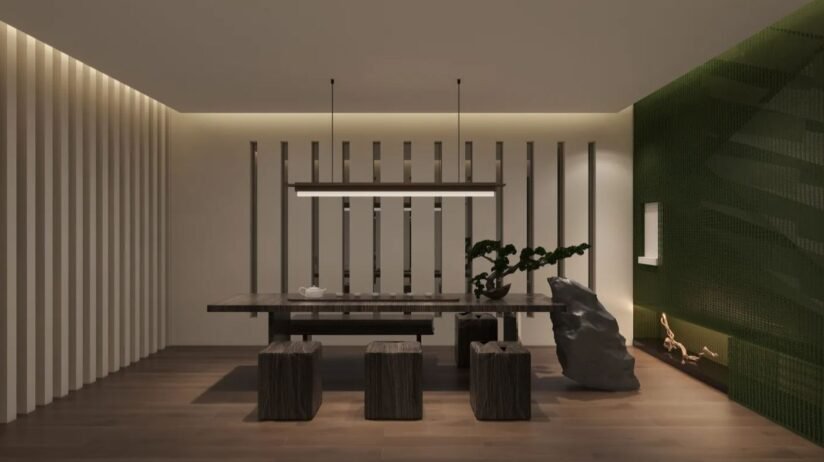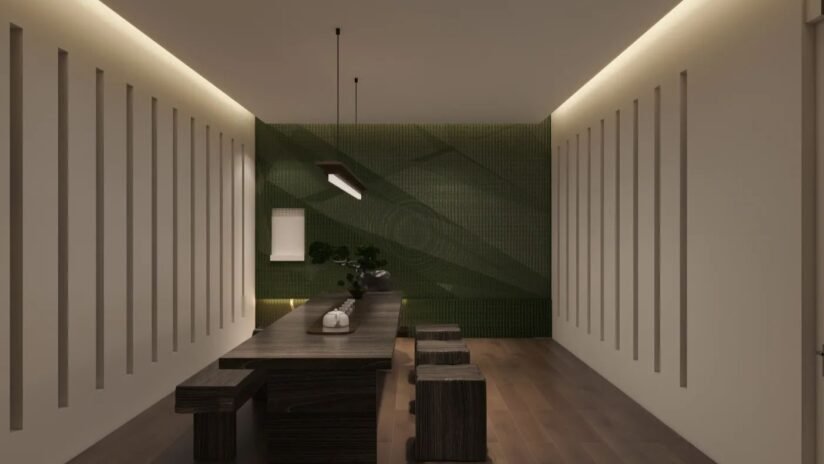
Tea Room Design: Minimalist & Natural
- Gloria A. Davis
- 0
- Posted on

Find inspiration for a calming tea room with a minimalist concept, neutral colors, natural elements, and unique lighting to create a harmonious and comfortable atmosphere.
Imagine sitting in a peaceful tea room, surrounded by soft lighting and the soothing aroma of tea. Tea room design is not just about aesthetics but also about creating an atmosphere that promotes relaxation. The combination of minimalism and natural elements creates the perfect harmony.
This time, we will explore how to bring a minimalist concept into your tea room—from color selection and natural materials to lighting, which plays a significant role in setting a cozy ambiance. Let’s dive in!
Minimalist Design as the Essence of Beauty
Minimalism is about simplicity without losing aesthetic appeal. Tea room design applies this principle through neutral colors, functional furniture, and an organized layout.
Neutral Colors and Simple Elements
Shades like white, beige, and gray are the top choices for creating a serene atmosphere. These colors help calm the mind, making the tea-drinking experience more relaxing.
Functional Furniture with a Clean Look
In a minimalist tea room, furniture is not just decorative but must also serve a clear purpose. Simple tea tables, low Japanese-style chairs, or even floor cushions are the best choices. There are no excessive elements—only what is truly needed.
Natural Touch with Organic Materials
Incorporating nature into the room adds warmth and authenticity. Choosing wood, bamboo, and stone makes the space feel more alive and natural.
Utilizing Wood, Bamboo, and Stone
- Wood: Tea tables, floors, or shelves made of wood bring a natural and elegant feel.
- Bamboo: This lightweight material is perfect for wall accents or partitions.
- Natural stone: Used for tables or floors, it adds a cool and exclusive touch.
Integrating Green Elements
Nothing is more refreshing than a touch of greenery indoors. Add houseplants or a green accent wall to create a fresh, natural ambiance.

Walls and Ceilings with Geometric Patterns
Geometric patterns on walls and ceilings can be a great way to add character to a tea space design.
Visual Effects of Geometric Patterns
Straight lines or box patterns provide a modern look without sacrificing comfort. These patterns can be applied through paint, wallpaper, or carved wood panels.
Combining with Dark Colors
Add dark colors like black or deep brown as accents to avoid a monotonous look. These tones create elegant contrast without disrupting the balance of minimalist design.
Harmony with Dark Wood Floors and Unique Lighting
Aesthetic Appeal of Dark Wood Flooring
Dark wood flooring adds depth to the room, making it feel warmer. Additionally, dark colors are more resistant to stains and scratches, making them a practical choice.
Choosing Unique Hanging Lamps
Lighting is not just about illumination but also about decorative elements. To add character to your tea room design, opt for unique hanging lamps made of bamboo or frosted glass.
Wrap-up
The ideal tea room design blends minimalism, natural elements, and geometric patterns. Selecting the right colors, materials, and lighting creates a space that is both comfortable and aesthetically pleasing. With this combination, a tea room becomes more than just a place to enjoy tea—it transforms into a sanctuary of tranquility within your home.
FAQ’s
- What are the best colors for a minimalist tea room?
Neutral colors like white, beige, and gray are the best choices for creating a calm and cozy ambiance. - What materials are most suitable for a tea room?
Wood, bamboo, and natural stone are ideal for this space as they bring warmth and an organic feel. - How can I add green elements to a tea room?
Use houseplants or create a green accent wall to enhance the refreshing atmosphere. - Are geometric patterns suitable for a tea room?
Yes, geometric patterns on walls or ceilings add a modern touch while maintaining a comfortable vibe. - What benefits does dark wood flooring have in tea room design?
Dark wood flooring provides depth, warmth, and better resistance to stains and scratches.